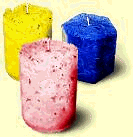The Tellico Plains Mountain Press
Candle Making

Candles brighten any season
However, along with an increase in popularity has come a corresponding increase in cost. But, if you make the candles yourself, you can give the gift of illumination without breaking your budget. It's surprisingly easy – and a lot of fun – to make beautiful candles.
SUPPLIES
Wax...You can purchase large slabs wax at most craft stores, or, for a better price and a more manageable size, visit the canning section of the grocery store.
Wax Additives...There are wax additives available to improve the quality your candles. For instance, stearine flakes can be added to make your candles burn longer. These additives aren't necessary; you can certainly make beautiful candles without them.
Color....You can purchase specially formulated candle colors at the craft store, or go with a less-expensive alternative – crayons! In addition to being readily available and inexpensive, crayons come in a much broader array of colors.
Scent....Candle scents are often available at craft stores. An alternative to specially formulated candle scents is perfume. However, unlike the previous alternatives to specially designed products; perfume is frequently the more expensive option.
Wicking...Wicking is available at any craft store selling candle-making supplies. There are many different kinds of wicking, and what you should purchase depends largely on the type of candles you're planning on making. Check with the sales people or read the information on the packaging to decide which type is best for you.
Candle Molds....Molds made especially for candles can be purchased, or you can improvise with household items. For instance, individual sized paper milk cartons are good for square candles and juice glasses can make nice column candles.
Double Boiler...Wax should always be melted in a double boiler to prevent it from overheating and igniting on the stove.
BASIC PROCESS
1. If you're using household objects to mold your candles, coat the insides lightly with vegetable oil. This will help release the cooled candle. Remember, if you pick a mold that's wider at the bottom than the top, you won't be able to remove the candle!
2. Position the wick in the mold. Most candle molds are designed for easy wick positioning. With household objects, often a piece of scotch tape will hold the wick to the bottom. Tie the top of the wick around a pencil or thin dowel laid across the top of the mold to hold it upright while the wax dries.
3. Once the molds are prepared, begin melting the wax in a double boiler placed over a medium to low-medium burner. Wait until the wax is completely melted before adding any additives, colors, or scents.
4. Pour the wax into molds. Do not work over the kitchen sink unless you have lined it thoroughly with newspaper. As the wax begins to cool, it will probably get a "dimple" in it. Pouring another 1/4" of wax in the mold can fill this.
5. When your candles have completely cooled, remove them from the molds by gently tugging on the wick. Most candles take about six hours to cool completely, depending on their size. If you're in doubt, let them cool longer.
6. After you've released your candle from the mold, trim the bottom wick flush and the top wick to about 1/4".
VARIATIONS
The above steps make the most basic of candles. There are many variations you can introduce into the basic process to make even more personalized and creative candles. Below are a few to help spark your imagination:
Candles with leaves or pressed flowers Make candles following the basic process. After you have unmolded your candles, affix dried leaves, leaf skeletons (available at craft stores if you can't find them locally), or pressed flowers to the candle by painting a thin coating of decoupage medium on the back of the leaf or flower. Once coated, press onto the candle in your desired design. Larger stems can be glued down with undiluted craft glue. Apply a coat of decoupage medium over the entire surface of the candle, including the leaves and flowers, and let dry. White glue thinned slightly with water can be substituted for decoupage medium.
Ice Crystal Candles
Make candles following the basic process. While the wax is melting, crush ice cubes in your blender or food processor. Just before pouring the wax, fill the mold about 3/4 full with crushed ice. Carefully unmold over a towel or sink to soak up the melted ice.
Coffee bean and Cranberry Candles
These candles are both extremely popular and expensive to buy ready-made. Coffee beans, cranberries, and dried flowers are just a few of the things you can add. Before beginning mass production, test one of the items you'd like to add to your candle to determine if it sinks or floats. Floating objects should be used in candles where the top of the mold is the bottom of the candle, and sinking objects should be used where the top of the mold is the top of the candle. From there, it couldn't be easier. Just follow the basic process, but don't fill the mold completely when pouring. Then, add enough of your chosen item to fill one-eighth to one-quarter of the candles' depth, depending on your preference. Cool and unmold as usual.
